French Line To The Caribbean
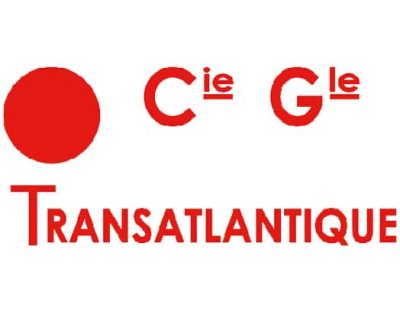
 This very beautiful twin funnelled intermediate liner was built for French Line service to the Caribbean islands, the north coast of South America, and Central America, and is one of my favourite liners of all time. She was completed in 1931 by the Dunkirk yard of Ateliers et Chantiers de France, and served for 24 years out of her long 43 year career to the warm Caribbean. She was launched on 18th July 1931 in the middle of the Great Depression with her owners having racked up a trading loss of 236 million French francs during the year. French Line or Compagnie Generale Transatlantique (CGT or Transat for short) had to form Compagnie Financiere Transatlantique during the year to cope with the ever increasing borrowings needed to carry on trading in each worsening year of the Depression. Many older liners were sold off and their large fleet was reduced to only 52 vessels.
This very beautiful twin funnelled intermediate liner was built for French Line service to the Caribbean islands, the north coast of South America, and Central America, and is one of my favourite liners of all time. She was completed in 1931 by the Dunkirk yard of Ateliers et Chantiers de France, and served for 24 years out of her long 43 year career to the warm Caribbean. She was launched on 18th July 1931 in the middle of the Great Depression with her owners having racked up a trading loss of 236 million French francs during the year. French Line or Compagnie Generale Transatlantique (CGT or Transat for short) had to form Compagnie Financiere Transatlantique during the year to cope with the ever increasing borrowings needed to carry on trading in each worsening year of the Depression. Many older liners were sold off and their large fleet was reduced to only 52 vessels.
Design And Construction
Colombie was designed to be a fast twin screw passenger and cargo-liner able to accommodate 491 passengers in three classes and 157,000 cubic feet of cargo in four holds and cold rooms, some of her cargo being bananas and fruit. She needed a reliable form of propulsion to maintain a service speed of seventeen knots on her busy schedule of six week voyages to a dozen Caribbean discharging and loading ports, and with enough reserve power to make up time if delayed at any of these ports.
Colombie was launched down her slipway with her twin funnels and twin masts in place, and bedecked with flags, and with all of her main and auxiliary machinery in place, and her hull painted black and her accommodation white, including a white part of her upper hull beneath her fo’c’stle and beneath her poop. She thus had a very short fitting out period and was able to make a trial trip across the Channel to view the Schneider Cup air race off the eastern end of the Solent on 2nd September 1931. She was fully ready in October 1931 as an intermediate liner of 13,391 grt and was named after one of the countries she would regularly visit, the country of Colombia. She had two red cylindrical funnels with black tops, the second one being a dummy allowing ventilation to the turbines. She sailed on her maiden voyage on 2nd November 1931 from Le Havre and Plymouth to a dozen ports around the Caribbean including Puerto Colombia in Colombia.
She returned to her home port six weeks later, and sailed again between Christmas and the end of December 1931 on her second voyage to the Caribbean. She shared this important route to the French Caribbean possessions with three other twin funnelled intermediate liners in Cuba built in 1924, Flandre built in 1914, and Pellerin de Latouche built in 1913, and the single funnelled Macoris built in 1902 for Deutsche Ost-Afrika Linie and ceded to France in 1919 as war reparations. The long distances covered by the route dictated the form of propulsion for the new liner, that of twin sets of reliable Parsons double reduction geared steam turbines taking steam from seven boilers and developing 8,800 shaft horse power to twin propellers giving a service speed of seventeen knots on the long voyages. They were manufactured by the Penhoet yard at St. Nazaire, and she had a maximum speed of over eighteen knots to make up time if delayed.
Colombie had an overall hull length of 508.6 feet (488.0 between perpendiculars), moulded beam of 66.7 feet, and a fully loaded draft of 26.4 feet with a deadweight tonnage of 7,554 tonnes. She had a full load displacement tonnage of 16,330 tonnes when carrying a full cargo and with her bunker tanks filled to the top with 2,900 tonnes of oil fuel. She had four holds and four hatches for carrying tropical produce with refrigerating machinery to keep them in good condition while they were quickly moved to France. She had eight cargo derricks on the two masts for cargo handling, and had a total of six decks, with three in her hull and three in her long Bridge Deck of length 252 feet. She carried a total of 491 passengers in three classes, 201 in First Class, 146 in Second Class, and 144 in Third Class, and a crew of 251 Frenchmen.
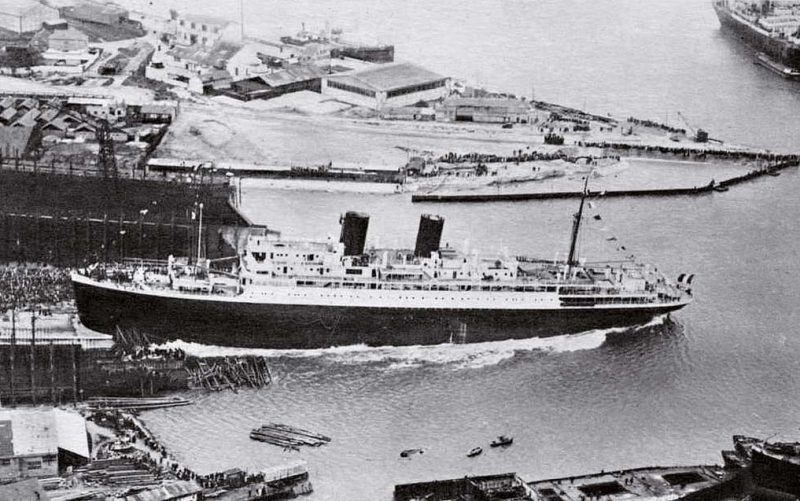
First Class passengers had the use of the large Main Lounge, large Smoking Room, Nursery, Ladies room, and a Verandah Cafe on Promenade Deck, with a two deck high Main Dining Room on a lower deck. This luxurious Dining Room had wall length mirrors, with seating easily adaptable from long tables seating forty to small tables seating groups of eight, six, four and two passengers. The large Lounge and Smoking Room were both light and airy with wooden tables and beautifully upholstered chairs and sofas. The First Class Staterooms were very roomy with comfortable beds, two matching washbasins with mirrors above, and padded easy chairs and sofas. The First Class marble swimming pool was on a lower deck and of a generous rectangular size with adjoining changing rooms. Second and Third Class passengers each had the use of their own General Lounge, Smoking Room, Ladies Room, and Dining Rooms on lower decks.
Colombie had a slightly raked bow, a graceful counter stern, oil fired boilers, forced hold and cold store ventilation for her banana cargoes, and the latest navigation equipment on her bridge, and seven large windows on the front of her wooden wheelhouse for good forward visibility. She was thus equipped in every way to visit the colourful ports, showing off her proud French Tricolor, that she visited on each voyage, namely Pointe a Pitre and Basse Terre on Guadeloupe, Fort de France on Martinique, Barbados, Trinidad, La Guaira and Carupano in Venezuela, Curacao and Aruba, Puerto Colombia and Cartagena in Colombia, Cristobal at the Caribbean end of the Panama Canal, and Port Limon in Costa Rica.
Career of Colombie
Colombie inaugurated the new deep water berth at Pointe a Pitre on Guadeloupe on 20th April 1934, and made a 22 night Baltic ports cruise from Le Havre on 25th July 1934, returning on 16th August with prices from 3,500 French francs. She then sailed three days later on an eleven night Northern Capitals cruise with prices from 1,350 French francs. She received an all white hull and livery in early 1935, which greatly improved her appearance. She made Southampton her U.K. port of call instead of Plymouth from 25th February 1935, and at the end of the year made a special month long Caribbean cruise to celebrate the tricentenary of the French West Indies colonies and of Guyana. Summer months each year during July and August from 1936 onwards she went cruising from Le Havre to Baltic ports and Leningrad, and in summer 1939 she cruised from Le Havre to American and Canadian ports as well.
Colombie was requisitioned by the French Government on 29th September 1939 in Bordeaux and converted into an auxiliary cruiser at Cherbourg that lasted until 14th February 1940, when she was renamed X10. She was fitted with a main armament of six 152 mm guns, two each on the centreline at her bow and stern, and two placed laterally. A secondary armament of two 75 mm guns was placed at the edge of her top deck between the funnels, and she also carried two 37 mm and two 13.2 mm anti-aircraft machine guns with semi-automatic firing. She moved around to Brest in April 1940 to embark 1,500 French troops and mobile guns for the Norwegian campaign, but after the German breakthrough into northern Norway in late May she returned with all haste to France.
She then moved around to Marseille to embark 1,500 troops for French North African ports, but was laid up at Toulon and then Marseille after derequisition on 7th September 1940 after the fall of France. She was returned to French Line, her armament was removed and she was renamed Colombie. She participated in the repatriation of French troops and civilians from Beirut in Syria between August and October 1941 after the Armistice of St. Joan of Arc. She was then sent for lay up at Bone in North Africa and was still there a year later when American and British troops launched Operation Torch into North African ports. She was seriously damaged by an aerial bomb demolishing her forward funnel at Bone, and was repaired at Algiers. She arrived at Dakar on 15th December 1942, and then moved up to Casablanca on 23rd February 1943 where she was chartered by the American authorities on 8th March 1943.
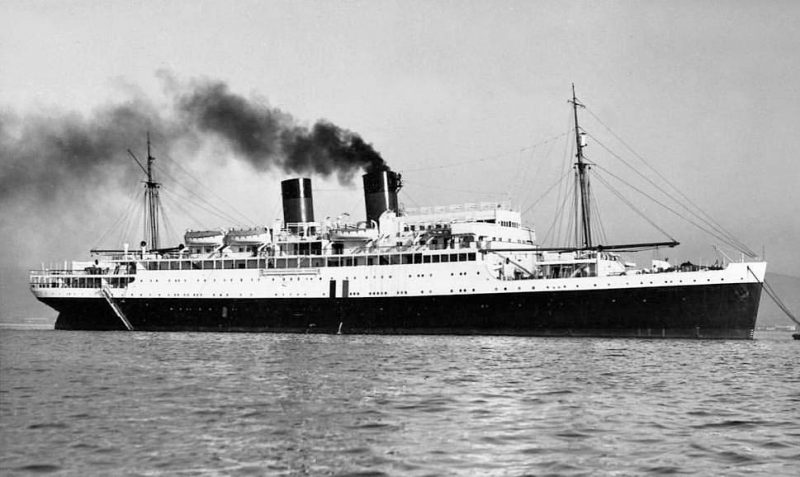
She then sailed for New York to be fully converted into a troop transport carrying 2,300 troops, and after the fall of Italy she made many troop voyages from New York to Italian ports between October 1943 and December 1944. In January 1945, she was converted into a hospital ship by the Arthur Tickle Engineering shipyard in New York and renamed Adela E. Lutz in honour of a U.S. Army lieutenant killed in an aeroplane crash over southern France in November 1944 after having participated in 190 missions to rescue wounded personnel. She remained under the American flag for a year, but returned to Le Havre on 15th May 1945 after the Armistice to make several austerity voyages to the Caribbean and from Casablanca to Bordeaux, repatriating over seven thousand people. In September 1945, air conditioning was fitted throughout the ship by the Todd Brooklyn yard at New York in readiness for a move into the Pacific to Manila, but this was aborted when her main bearing failed at Honolulu. On 21st February 1946, she sailed from Honolulu bound for New York. She was returned to the French authorities on 11th April 1946 at Le Havre, and after a short refit she was renamed Colombie and made one voyage from Marseilles to French Indo-China, and then returned to her Caribbean route, with one of these voyages calling at New York and another in North Africa.
Modernisation At Vlissingen
By now, she was in a poor condition throughout due to her arduous war service, for which she had received the Croix de Guerre from the French President. She was sent in September 1948 to the Royal ‘De Schelde’ shipyard at Vlissingen in Holland, now part of the Damen Shipbuilding Group. She was completely refurbished internally in a two year refit that altered her passenger accommodation to 192 First Class, 140 Cabin Class, and 246 in the new Tourist Class. Some of the First Class and Second Class staterooms were now interchangeable between the classes. She now measured 13,803 gross registered tons, and had been revitalised into virtually a new modern looking liner.
The accommodation of her Upper Deck was extended to her stern, and several sideports were cut into both sides of her hull to work cargo and allow pilots to embark and disembark. The accommodation was reworked so that 90% of the First Class staterooms had private bath and toilet facilities, and half of Second Class cabins also had this facility. She now boasted two swimming pools, a children’s playroom, a gym and a roomy cinema. Beneath decks, the turbine blades were thoroughly examined and replaced where necessary and her seven boilers were replaced with new ones. A single new wider funnel with a stylish ‘wavy’ top replaced her earlier twin funnels. She returned to Le Havre in November 1950 and immediately took up her familiar six week Caribbean voyages, again with a white hull.
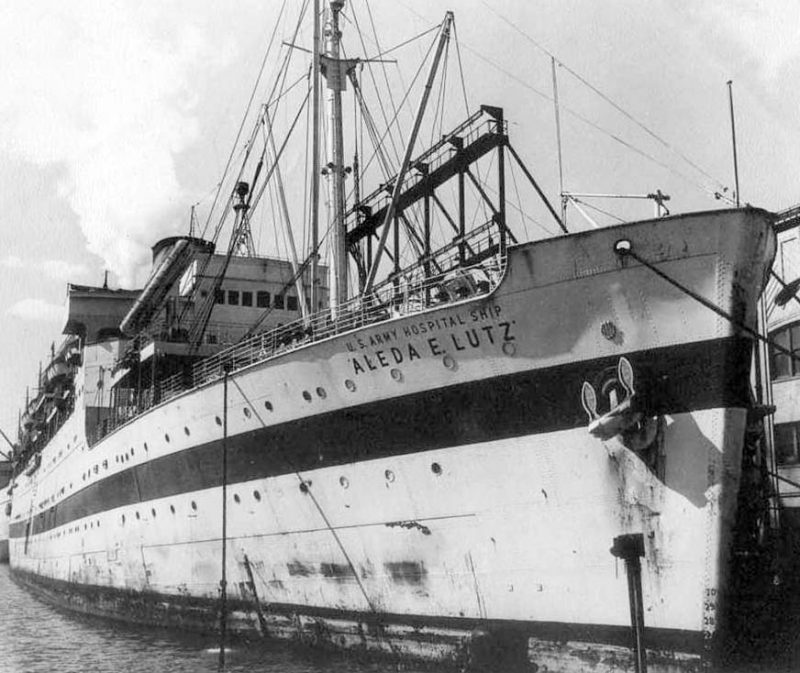

The French Line liner De Grasse of 17,759 grt with a black hull partnered Colombie at the end of April 1952. She was the first passenger liner on the North Atlantic to be designed as a Cabin Class ship. She also now had a single funnel after being completed with two funnels in 1924 at Birkenhead by Cammell, Laird & Co. Ltd. She had been sunk at Bordeaux by the retreating Germans in August 1944, and was then raised in September 1945 for a refit at St. Nazaire that took two years. She made her first Le Havre to New York sailing on 12th July 1947, and then partnered Colombie to the Caribbean from 24th April 1952.
De Grasse was sold to Canadian Pacific Steamships Ltd. on 26th March 1953 to replace their burnt out Empress of Canada at Liverpool for Canadian sailings. Colombie was now partnered by the new liner Antilles of 19,828 grt completed with a white hull in December 1952 for the popular winter cruising season in the Mediterranean. Antilles had accommodation for 402 in First Class, 285 in Cabin Class and 976 passengers in the new Tourist Class, and dimensions of a few inches short of 600 feet in length, moulded beam of 80.3 feet, and draft of 26.2 feet, and a service speed of 22 knots from twin double reduction steam turbines. Antilles could make Fort de France in seven days from Le Havre directly, but always included calls at Southampton, Vigo and San Juan. The amended post-war Caribbean port rotation with Colombie was now Pointre a Pitre, Fort de France, La Guaira, Trinidad and Barbados, with Antilles making her maiden Caribbean sailing in May 1953.
Flandre, the black hulled sister of Antilles and designed for the North Atlantic run to New York, helped out Antilles and Colombie on the popular French Line winter cruising programme to the Caribbean. She did this for each of the winters until she became full time on the Le Havre to New York express route in 1958. Then, when Colombie was withdrawn from service in December 1962, Flandre came off the North Atlantic after being replaced by the stylish new France and was given a white hull to partner Antilles, also with a white hull, on the Caribbean run.
Meanwhile, Colombie had collided with a Spanish coaster named Conde de Barbate in the approaches to Vigo on 12th October 1951, with the unfortunate loss of five crew members from the sunken coaster. On 4th November 1956 while docking at Fort de France she violently hit the Quai des Tourelles, suffering badly damaged and leaking bows. She was repaired at San Juan, and later in 1961 was adapted to carry French West Indian troops to France for military service. Colombie also carried many French colonial plantation and civil island authority staff to the Caribbean, as well as the well known boxer Sugar Ray Robinson on one occasion.
On 3rd June 1962, one voyage from Le Havre by Colombie was cancelled due to an electrical failure, but she returned to service for her next voyage on 8th July. Three days out on this voyage, she rescued one crew member of the German tug Seefalke who had become violently ill off the Azores. Later that month, French Line tried to sell Colombie to an American group that planned to use her for a series of Mexican cruises along the Pacific coast. This planned sale fell through, and Colombie was withdrawn from Le Havre to Caribbean service in December 1962. Colombie ended her French Line career on 17th March 1964 when she was sold to Greek owners in Piraeus, and was taken over by her new owners, the Aegean Steamship Navigation (Typaldos Brothers Steamship Co. Ltd., managers) in Marseille.
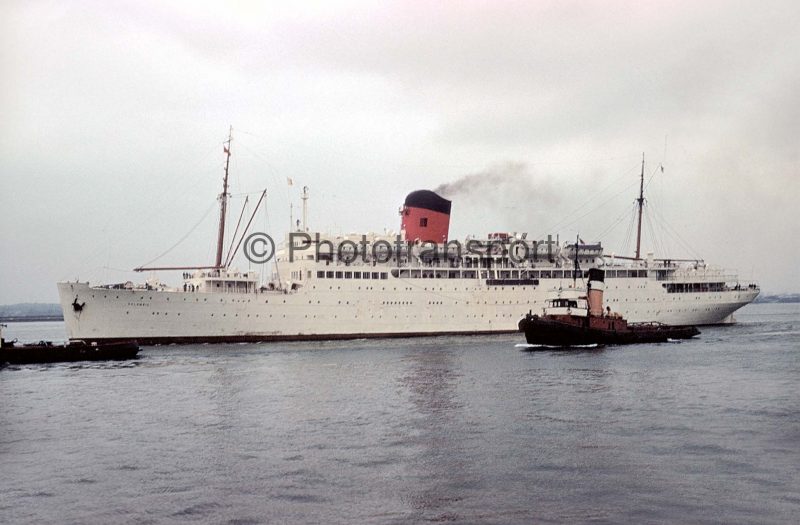
Sale To Typaldos Brothers Of Greece
Colombie was given a yellow funnel with a blue stylised ‘T and P’ logo instead of her deep red French Line funnel. She was renamed Atlantic at first and then Atlantica for a series of Mediterranean cruises from Piraeus as well as a series of timetabled liner voyages from Venice to the Eastern Mediterranean. She sailed regularly from Venice to Split, Cephalonia, Piraeus, Crete, Limassol, Haifa, Rhodes, Izmir, Piraeus, Katakolo, Corfu and a return to Venice. She had accommodation for 763 passengers with 194 in First Class, 327 in Cabin Class and 242 in Economy Class. She was fitted with a drive on, drive off garage for 140 cars, as well as a pole mast above the navigating bridge for the radar scanner. Typaldos Brothers failed financially in 1968, and Atlantica was laid up at Piraeus, and remained laid up and swinging at a buoy at Perama until sold for scrapping in 1970 at Perama, where she was partially stripped down to a bare and empty hull. The hull was finally sold for breaking up at Barcelona in 1974 by the firm of D. Decasa.
The sale of the hull of the beautiful Caribbean liner Colombie for her final breaking up at Barcelona was very sad, but she had outlasted her post-war running mate of Antilles. The latter ship struck an uncharted rock off Mustique, one of the islands to the south of St. Vincent, on 8th January 1971 while on a nine day cruise from San Juan under the command of Capt. Kerverdo with 635 passengers and a crew of 350. The impact ruptured the fuel tanks and the escaping fuel caught fire, triggering massive explosions in the engine room, and she burst into flames. Capt. Kerverdo sent out an S.O.S. and ordered his passengers and crew into the lifeboats. An hour later, the ship was fully ablaze, and all of her 635 passengers were picked up by the French Line cargo-liner Suffren built in 1966 and French Line banana carrier Pointe Allegre built in 1969, and they were then transferred to the luxurious accommodation of Queen Elizabeth 2 of Cunard Line to recover from the ordeal.
The fire spread rapidly onboard Antilles, and soon she was consumed by flames from stem to stern, with her hull collapsing first into two pieces on the following day and then into three pieces as her superstructure collapsed into her hull. The remains of Antilles lie scattered at the bottom of the uncharted rock. She was replaced two months later by the purchased Tyne built liner Bergensfjord of 1956 of the renowned Norwegian Amerika Line, renamed as De Grasse (2) to take over the heavily booked Caribbean cruise programme of Antilles.
De Grasse (2) had a short career with French Line to end the passenger service of the company to the beautiful Caribbean islands. She was given a six month refit for winter cruising to the Caribbean from Le Havre and Southampton with 581 one class passengers. She entered service on 21st November 1971, and while initially profitable nothing could hide the fact that this was an older ship, and she was quickly transferred to winter cruising from San Juan and summer cruising in Europe. She survived the winter cruising schedule from San Juan in 1973/74, but at the end of her cruising programme she was sold to Thoresen & Co. Ltd. and Bruusgaard Kiosterud & Company of Singapore, and arrived in February 1974 at Singapore from San Juan.
In 1976, the French Government formed a company known as Compagnie Generale Maritime (CGM) to merge the fleets of French Line (CGT or Transat) and Messageries Maritimes of Marseille. The West Indies cargo trades were now containerised in the joint CAROL (Caribbean Overseas Line) consortium of CGM, Harrison Line, Hapag Lloyd, and KNSM of Holland. The Polish built Type B463 series of container ships of 1,412 TEU capacity totalled ten in number with Caraibe and La Fayette of late 1977 and early 1978 as the CGM contributions to the CAROL service. Four container ships named Fort Royal, Fort Fleur d’Epee, Fort Saint Charles and Fort Desaix of 1,512 TEU capacity of which 756 containers were refrigerated for the carriage of bananas and fruit entered service in 1979/80 to the Caribbean. This quartet was later replaced by even bigger CMA-CGM container ships trading to the Caribbean, which still maintain the best traditions of French Line on the islands service.
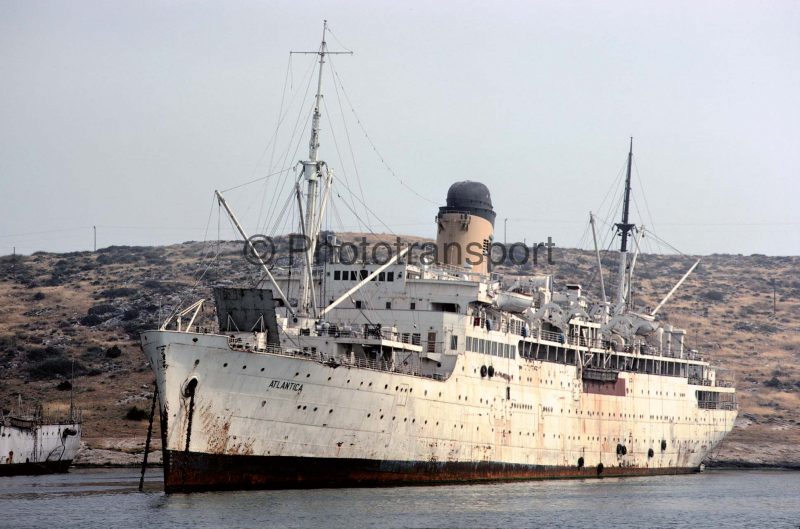
Postscript
In the early 1960s, British cruise passengers had a choice of two French Line destinations from Southampton, the first to New York on the very stylish twin funnelled France of 1960, with horizontal fins to throw out her exhaust smoke horizontally, or the equally stylish Colombie for a warm tropical Caribbean cruise. I know which one I would have chosen to sail on, the very beautiful liner that is the subject of this article, Colombie ! The beautiful French Line sisters Antilles on warm Caribbean cruising, or her sister Flandre on New York cruising were equally tempting choices, the warm option would again win out for me.
Colombie avoided all of the hazards of running aground on the many small islands and rocks of the Caribbean, unlike her unfortunate consort Antilles. French Line had used inter-island steamers between Guadeloupe and Martinique from around the turn of the century in 1900 e.g. Manoubia of 1,080 grt and based in Martinique from 1895. The ultimate disaster in the Caribbean was in the aftermath of the tumultuous volcanic explosion of Mount Pele on Martinique on 8th May 1902. The huge pyroclastic blast of lava rushed down the mountain and completely destroyed the main town of St. Pierre, killing over 30,000 people in a matter of seconds. French Line ships in the roadstead were able to ride out the ensuing tsunami, but St. Pierre was only partially rebuilt and never regained its former importance.
The French Line postcard and watercolour and oil painting images of Colombie cruising in the Caribbean give a fairly accurate picture of what it was like to cruise down all of the Leeward and Windward Islands, and then via Barbados and Port of Spain to cruise along the north coast of South America, ending at the Caribbean end of the Panama Canal or at Port Limon in Costa Rica. All of the island men stopped their fishing from boats or from the beaches to watch the beautiful white hulled twin funnelled Colombie glide to her anchorage or berth. There was a festive atmosphere on the quayside, but calls by Colombie were only one day in length to work cargo both discharging and loading. The local touts made the most of what time was available to offer all manner of trinkets for sale to passengers who had gone ashore.
Colombie was not unique as there were 175 similar twin funnelled deep sea liners in service when she was completed in 1931. French Line ships, however, always had great style during the 160 years of history before the company was merged into CGM along with Messageries Maritimes. The funnels of all of their passenger ships were beautifully styled to show off their uniqueness. The large French tricolor flew at their sterns, and during the war years was also emblazoned in red, white and blue paint on both sides of their hulls.
Colombie with her beautiful white hull, two red funnels until 1948 and one red funnel until 1964, and graceful counter stern, was way ahead in a class of her own for style. She was the second of that name in the French Line fleet, the first having been launched way back in 1862 at Greenock as the second ship in the fleet under the name of Floride of 1,860 grt with accommodation for 175 passengers in two classes, and was renamed Colombie in 1874 to continue sailing for Transat until broken up in Marseilles in 1897.
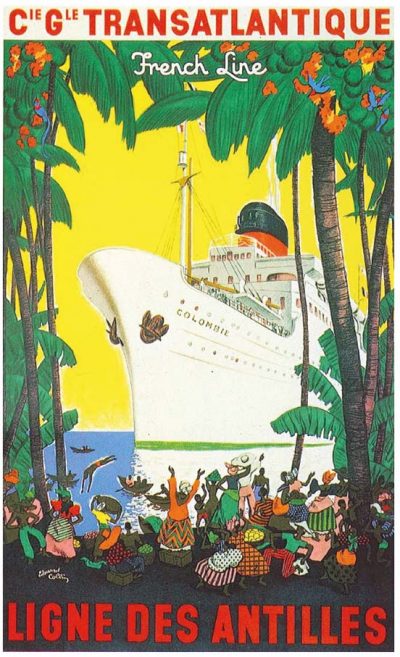




Comments
Sorry, comments are closed for this item